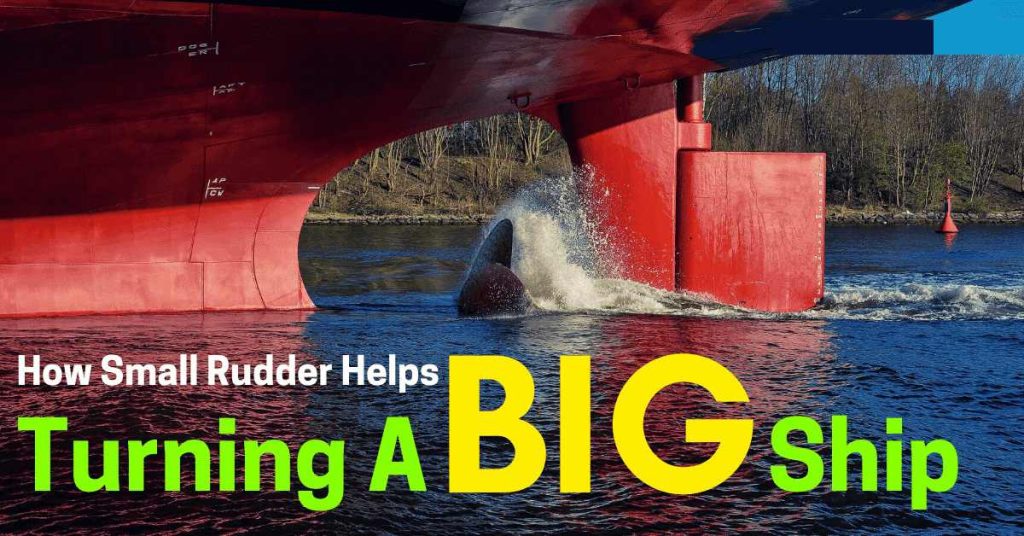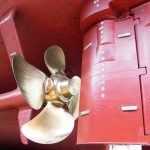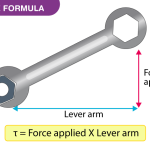Have you ever wondered why all ships have their rudders placed at the aft of their propellers? Why isn’t a rudder placed at the bow (forward) of the ship? Or for that matter, why is it always placed behind the propeller? Just imagine a ship with a rudder at its bow. Wouldn’t it look ugly? Well, we naval architects are least bothered about that, when it comes to ship design practices.
The first priority of any ship design, is the achievement of function-ability of the designed product, and then comes its aesthetic value. Rudders are placed at aft, instead of at the bow, not because of aesthetics, but because of its hydrodynamic efficiency when placed at aft.

To understand this, we need to delve into the mystery of the role of a rudder in a ship. Did you know that a rudder does not turn a ship? Yes, you read it right. So how does a ship turn, then? And if not the rudder, then what is it that turn’s the ship? Let’s for the entire article henceforth, assume a starboard turn. Which means, the rudder is moved to the starboard side. When the helmsman changed the rudder angle from zero to some angle towards the starboard, at that very moment, a lift force acts on the rudder. The direction of the lift force is towards the port side, as illustrated in Figure 1.

Figure 1: Rudder force on a ship with rudder to starboard
This rudder force, as you can see, is directed along a transverse direction to the ship. In other words, this force will cause the ship to attain a sway velocity towards the port side, because the rudder force is nothing but a sway force towards the port side. It is because of this, a ship will sway slightly to the port when the rudder is turned over to hard starboard. But this sway is so negligible in comparison to the turning moment towards starboard, that the sway is hardly felt. But yes, the sway does occur.
Other than this, the rudder force has another effect on the ship. It creates a moment about the centre of gravity of the ship, in the direction as shown in Figure 2. (To understand why is the moment directed in the direction shown, apply simple law of translation of a force into a moment about a point, or look at it like this- the centre of gravity of the ship is forward of the rudder, and given the direction of the rudder force, the moment it will create about the C.G will be along the direction shown).

Figure 2: Rudder moment when rudder is moved to starboard
Imagine the size of a rudder in comparison to the size of the ship. The rudder is incomparably smaller to the size of the hull that is to be turned by it. So, how does the rudder turn the ship? Well, as we saw before, the rudder doesn’t turn a ship. In fact, the rudder moment created by the rudder, is negligibly small to turn the ship by the required heading angle. If that’s the case, then what is it that turns the ship?
When the rudder moment acts about the ship’s centre of gravity, it slightly changes the ship’s orientation by giving it a drift angle (illustrated in Figure 3). This moment is not large enough to turn the ship to the required heading angle, but all a designer has to do, is make sure that the rudder moment is enough to introduce a slight drift angle into the ship’s movement. The ship, with that drift angle, is now moving along the initial direction. But this isn’t pure surge anymore. Follow Figure 3, and you’ll see you can make components of the ship’s velocity along the surge (longitudinal) direction and sway (transverse) direction. Thus, it’s evident, that by introducing a drift angle, the rudder has introduced a small surge velocity to the ship. Notice the direction of this surge velocity in the figure below. Doesn’t it reinforce the reason behind why there is a small sway towards the port side during a starboard turn?

Figure 3: Drift angle due to the rudder moment.
What happens after this, is what makes the ship turn. To understand the mystery behind the turning of a ship, let’s not focus on the surge velocity here. The prime focus should be on the sway component. Because, that sway velocity component, is what changes the hydrodynamics around the ship’s hull to cause it to turn. Follow Figure 4 as you read further. This figure focuses on the effect of the sway velocity and how it turns the ship.
With a sway velocity towards the port side, the hull sways towards port. When it does so, it exerts a force on the water particles that are in its port side. The water particles in turn, exert an opposite force on the ship’s hull, due to the inherent inertia of the water particles. The direction of this inertia force is always opposite to the sway velocity, since inertia force always opposes motion. So, the ship’s hull experiences an inertia force on its hull in the starboard direction. Now, this force can be categorised into two.
One, the part of it that acts on the stern of the ship (Inertia force at stern) and the other half acting at the bow (inertia force at bow). Follow the figure below, and you’ll visualize that the inertia forces at stern will create an anticlockwise (towards port) moment about the centre of gravity, whereas the bow inertia forces will create a clockwise (towards starboard) moment about the centre of gravity. Now, the hull is designed such that the sway inertia forces at the bow is more than that at the stern, therefore the resultant moment is towards the starboard direction as shown in Figure 4.

Figure 4: Hydrodynamic moment due to sway velocity
What’s important to know here is that when the hull exerts force on the water around it, during its sway velocity to the port, the inertia force exerted by the water on the hull tries to achieve an equilibrium, which means, the magnitude of the inertia force is in the order of the ship’s displacement. It is that large, a force. So, when the resultant hydrodynamic moment acts on the ship, its magnitude is in the order of the ship’s displacement. This moment (unlike the moment cause by the rudder force alone) is sufficient enough to turn the ship. But as you can see, this hydrodynamic moment wouldn’t have come to play, had the ship not attained a drift angle or a sway velocity component, which was mainly due to the action of the rudder. This, is enough to justify, that the rudder does not turn the ship. It only initiates a drift angle in the ship, which results in a hydrodynamic moment, which is actually the driving force behind the turning action.
The hydrodynamic moment, is in the same direction of the rudder moment (both trying to turn the ship to starboard). The rudder angle keeps the rudder moment intact, which in turn, keeps the hydrodynamic moment intact. Once the rudder is again brought back to midships, first the rudder force vanishes, which results in the diminishing of the rudder moment. It is only after that, the drift angle is reduced to zero, and the hydrodynamic moment becomes zero, therefore thwarting the turning action. It is due to this indirect linking of the rudder to the turning action, that ships are sluggish when it comes to manoeuvring with rudder action.
The resultant moment diagram for a ship performing a starboard turn is as shown in Figure 5 below.

Figure 5: Moments acting on a ship during starboard turn.
Coming to what does this entire theory have to do in relation to the positioning of the rudder behind the ship. Well, if you didn’t know of the above, it was impossible for you to even imagine like a designer, i.e. why a rudder is placed behind the ship. Now that you are aware of the real physics behind a ship’s turning, here is why a rudder is always placed at the aft:
· The rudder, when turned to starboard, creates a force towards the port (which we named, the rudder force). Note the direction of rudder moment that was created about the CG by the rudder force. The direction of the rudder moment was towards the starboard (so as to create a drift angle towards the starboard). Now imagine placing the rudder at the ship’s bow. Given a starboard angle to the rudder, the rudder force would still be in the port direction. But what about the moment about CG? Visualise this – The rudder moment would be towards the port, causing a drift angle towards the port, and the net hydrodynamic moment would cause the ship to turn to port. Whereas, you turned the rudder starboard for a starboard turn. See the problem?
· There’s another reason why rudders are never placed at the bow. It is to protect the rudder from collision damages. But this however, isn’t a primary reason. The primary one, is what you just read above.
· Lastly, why is a rudder always placed behind a propeller? Well, the propeller does nothing but increases the velocity of the water that flows out of its slipstream. And the lift generated (rudder force) is proportional to the velocity of water falling on it. So if a rudder is placed at the aft of the propeller, the increased velocity of the propeller outflow results in a greater lift force. It is only for this reason that a rudder is placed aft of the propeller. However, if a rudder is placed just forward of the propeller, it will have the same turning effect with respect to direction, but the magnitude won’t be the same, given the fact that the flow on the rudder is not as much as it would have been, had it been placed behind the propeller slipstream.



Comments are closed